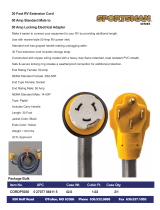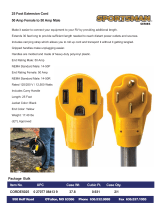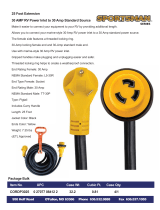
20
TD-000319-01-E
Proprietary DSP Functions
Excursion Limiting – The KLA Series system utilizes a proprietary limiter that prevents woofer over-excursion. Over-excursion occurs when a voltage
presented to the woofer causes the cone to physically travel too far. This builds up excessive heat, stresses the moving parts of the woofer, produces
audible artifacts and distortion and reduces the woofer’s lifespan. Voltages that will harm the woofer through over-excursion are reduced enough to
prevent over-excursion without any audible compression, limiting or loss.
DEEP™ – Taking advantage of the Excursion Limiter, the DEEP (Digital Extension and Excursion Processing) algorithm functions as a highly musical
and non-distorting low-frequency EQ circuit.
GuardRail™ – GuardRail allows the KLA Series amplifi er to deliver full peak power while preventing detrimental overloads. During excessive clipping,
or extreme overheating, GuardRail reduces gain just enough to preserve the integrity of the music, protect the speakers and keep the audience
excited, without unprofessional distortion levels or shutdowns.
Intrinsic Correction™ – Introduced on QSC Concert/Touring products, Intrinsic Correction is a proprietary process and set of signal processing
algorithms that address correctable intrinsic characteristics of transducers, waveguides and enclosures. The net result is that any KLA12 system will
present extraordinarily even and consistent energy throughout the physical listening area of the loudspeaker, resulting in a very musical, acoustically
transparent system.
Ar-Q™ – Arcuate Equalization (Ar-Q) processing automatically makes the appropriate equalization adjustments based simply on the number of boxes
in the array.
User-set DSP Functions
Refer to — Figure 32.
ARRAY SIZE (BOXES)
Set the ARRAY SIZE (BOXES) dial, on all KLA12s in the array, to the number of
KLA12 boxes in the array. For example, if there are three KLA12s in your array,
set the dial to "3" on each KLA12 in the array. The system automatically tunes
and confi gures the array for the selected number of KLA12 boxes. The result is
an evenly balanced and accurate tonal curve from your KLA line-array system.
Low-frequency EQ (LF SETTING / MODE)
NORMAL – This is the factory setting which equalizes the loudspeaker system
to provide an optimum balance between low frequency extension and
maximum output. This is the standard setting for most applications.
EXTERNAL SUB – (KLA12) When using the KLA12 with a KLA181 or KW181,
the switch should be set to the EXTERNAL SUB position to engage the 100 Hz
high-pass fi lter. This routes the frequencies above 100 Hz to the KLA12, and
the frequencies below 100 Hz to the KLA181 or KW181.
DEEP – For extra low-frequency extension and low-end presence, select the DEEP setting. DEEP provides increased low-frequency extension without
causing distortion or woofer over-excursion. Use this setting if you are using the KLA12 without a KLA181 subwoofer.
Subwoofer Polarity
Polarity refers to the voltage of an input signal and whether it is positive or negative at any given time. In most cases a positive voltage causes a woofer
cone to move forward with respect to the cabinet orientation, and a negative voltage then moves the woofer cone backward. Most importantly,
speakers reproducing the same signal or signals that are adjacent in frequency must have the same polarity to get the maximum output. This is most
important for low frequencies. Polarity can be altered by incorrect wiring or mixer control settings.
When using the KLA181 with KLA12 full range loudspeakers, NORMAL polarity will result in the best bass response IF the full range loudspeakers are
very close to the subwoofers, for example, stacked on top of, in the same vertical array, etc. If the subwoofers are some distance away from the full
range loudspeakers, polarity change may be of benefi t. Start with all subwoofer POLARITY switches in the NORMAL position. Then, with the system at
or near expected operating levels, change the polarity of each subwoofer (or co-located subwoofers) individually. Walk around the venue and assess
the overall bass response. Select the polarity that results in the best overall system bass response.
— Figure 32 —























